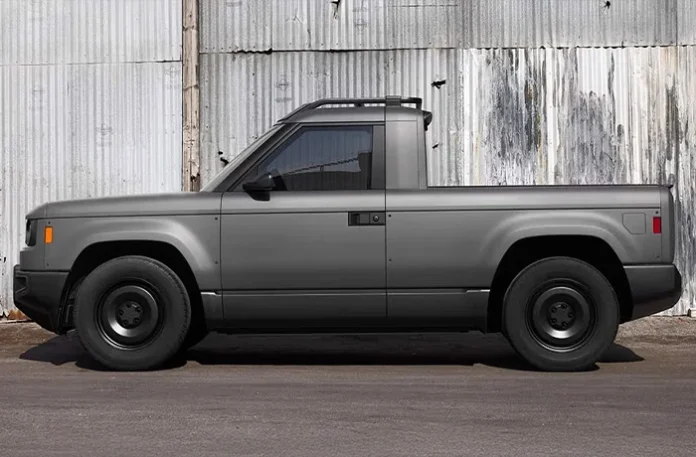“Nobody,” Tisha Johnson declared, in a careworn voice betraying three consecutive days of jet-lagged speech-giving, “wants a bunch of tech in their car.” Not exactly what you’d expect to hear from a senior executive of any Amazon-backed firm, let alone one devoted solely to the production of a controversial new electric vehicle, but the audience didn’t seem worried. Hundreds of them, mostly automotive industry employees and media personnel, had come from around the world to the “Car // Design Event” in Munich. While there was plenty of eye candy on offer, from an irreplaceable 1972 BMW Turbo supercar prototype to the global premiere of a new subcompact bearing the infamous Yugo name, most of the attention was on Johnson and two hastily 3D-printed, shoebox-sized models of the electric pickup she’s designed. It’s called “Slate,” and it’s already generated more than 100,000 $50 deposits from eager would-be customers.
As with Ben Franklin a full 249 years ago, Johnson’s task in Europe is significantly different from what she faces back home in America. Stateside, the very idea of a $20,000, after taxpayer subsidy, as is par for the course with electric vehicles, electric pickup with room for just two people and a modest amount of cargo in a tidy 5-foot bed is a bit heretical. As a red-blooded Ohioan, your author drives a pickup that could carry one Slate crosswise on the pickup box while towing a string of four more Slates behind it, and I’m a long way from having the most serious truck on my street. This country hasn’t been particularly excited about compact trucks since the debut of the 1982 Chevrolet S-10. Many people believe this lack of enthusiasm to be the direct fault of the aforementioned S-10.
Our continental cousins, by contrast, are a little different as car consumers. Many of them have already been browbeaten by a witches’ brew of regulation and taxation into ownership of a battery-powered, golf-cart-sized penalty box. For them, Slate needs no apologies for its size or even for its unimpressive standard range of 150 miles between charges. So here in Germany, rather, the challenge facing Johnson was a little snobbier: Why buy an electric pickup from an Amazon-affiliated startup when we have dozens of EV options from the established brands?
It turns out that while the questions might be quite different on the two sides of the Atlantic, the answers and the core Slate message remain the same, because the size and propulsion method of this diminutive electric truck are its least controversial qualities. You’d have been just as accurate in characterizing the original Honda Accord as “a bigger Civic with two additional headlights,” or calling the first Volkswagen Beetle “a low-buck Chrysler Airflow clone without a radiator.” Like the Accord and the Volkswagen, Slate’s truck aims to permanently change the automotive universe for just about everyone.
Start with the name. Not to be confused with the increasingly distraught and disheveled online magazine Slate, which publishes deathless prose like last week’s “My Husband Led Me to the Bedroom and Revealed My Anniversary Gift. Oh No,” the Slate truck gets its name from both the single color in which it is offered — “It was always, always, always going to be slate grey,” Johnson said — and the notion of it being a “blank slate” for customization and improvement.
Slates will leave the assembly line with just one possible difference: a choice of battery capacity. In all other respects, they will be identical, because that’s the cheapest way to do it. But they are unlikely to stay that way, because Johnson’s team is working around the clock on different parts that can be swapped in after the fact. Some of them are frivolous, such as the various replacement grilles and external accessories that have “Slate” in block letters, cursive, or not at all. Others are critically serious, such as the $5,000-proposed-MSRP pack that turns the Slate into a five-person SUV with your choice of fastback or station-wagon rooflines. Want a different color? For about $500, you can get a vinyl wrap pack in pretty much any shade. Johnson and her team practiced applying the vinyl themselves over and over again. When it proved to be too difficult, they went back and redesigned the flanks of the truck to make the task easier.
In Munich, Johnson waxed eloquent on the two occasionally conflicting goals for Slate: to be “lovable,” and to achieve affordability through being “intentionally simple.” When pressed on the choice to make Slate electric, she noted that “Our data shows that’s the lowest-cost path, with the most reliability, and that’s what we want for our customers.” Rather than build in a series of screens or interfaces, the Slate is “bring your own device.” Plug your phone or tablet into the universal mount on the center of the dash — that is your infotainment system. The interior is all plain surfaces and open space. “Indulgence on the part of designers,” Johnson asserted, “costs the customer money.”
Slate intends to foster communities of owners who 3D-print or otherwise create their own parts for the truck, both to reduce costs and to increase the emotional bond between the Slates and their owners. Sometimes, Johnson managed to kill two birds with one stone: The round headlights that give the truck its friendly, welcoming face are the industry-standard 7-inch size, which is both affordable to produce and supported in the aftermarket by hundreds of mild-to-wild replacement options. The body panels that zip on and off for customization will also zip on and off for low-cost, at-home repair of minor crashes.
Sometimes, there is techno-wizardry behind the Slate’s aw-shucks presentation. The standard equipment wheels are just 17 inches in diameter and made from plain steel, but they were extensively engineered to maximize brake cooling with the minimum number of holes because drilling holes — you guessed it — costs money. Engineering the parts and accessories for DIY installation is tremendously more difficult than the traditional practice of “dealer-installed accessories,” which often require considerable adjustment or modification to work. Every Slate “pack” or part is designed to be installed by people with little to no mechanical ability, working in their driveways or apartment parking lots. The charging system allows for the possibility of Slate owners who have no option other than to run an extension cord out of their condo or dorm windows.
Much attention has been paid to Slate’s stated intent of delivering a U.S.-made pickup truck for a net $20,000, but Johnson’s team is perhaps more highly focused on the costs, difficulties, and risks of Slate ownership in the long term. These considerations have long been all but absent from the decision-making processes of the major automakers, and that goes double for truly awful and often highly unreliable EVs such as the Cadillac Lyriq or Chevrolet Bolt, both of which have acquired a reputation for extended periods out of service.
This relentless focus on lifecycle cost harks back to Henry Ford and the Model T, and as with many other long-buried notions, it feels almost dangerous to see it break back into the limelight. Since World War II or even before, the automobile has been sold to Americans and Europeans as a class marker and means of displaying wealth. How can you keep up with the Joneses, which really means getting ahead of the Joneses, when you’re both driving the same basic grey pickup? In an era where we largely define ourselves by our purchases rather than our accomplishments, who wants to be defined by the most affordable truck in America?
Similarly, customization after the purchase has always been derided as lowbrow, laughable, possibly criminal. What will the homeowners’ associations of America say when people start vinyl-wrapping their Slates with different colors, right out in front of God and everyone? Doesn’t that violate the HOA code? And how is a possible Tinder match or dinner date supposed to react when they walk out to see a Slate truck with a completely unique grille that the owner 3D-printed themselves? The school pickup lanes of 2025 tend to be an undifferentiated sea of silver and black upscale SUVs. What will people say when luridly wrapped and tastelessly customized Slates begin to pop up among them like Carnaby Street hippies accidentally wandering into a bank?
ZORA NEALE HURSTON AND THE FATE OF THE BLACK CONSERVATIVE
With close to $1 billion worth of funding and maybe 1 million possible customers watching from the sidelines, Slate is poised to do something genuinely world-changing. This means more than merely swapping the V-8 luxury sedans of Northern California for Tesla Plaids, or convincing a few math-challenged businesses to fill their fleets with Silverado EVs or Ford Lightnings. If Johnson and her people get their way, everything about the American and European automotive experience will have to change, as it did when the Honda Accord redefined the family sedan, or when the VW Beetle changed the definition of basic transportation. Except more.
Oh, and the biggest reason Johnson cited for buyers not wanting tech in their car? Because it wears out and becomes unusable, often within a decade. Unlike the mandarins of General Motors, Slate isn’t planning on its products becoming obsolete and worthless. These little trucks are intended to stick around for a long time. Which, if you consider automotive history to this point, is perhaps the most heretical idea of all.
Jack Baruth was born in Brooklyn, New York, and lives in Ohio. He is a pro-am race car driver and a former columnist for Road and Track and Hagerty magazines who writes the Avoidable Contact Forever newsletter.


